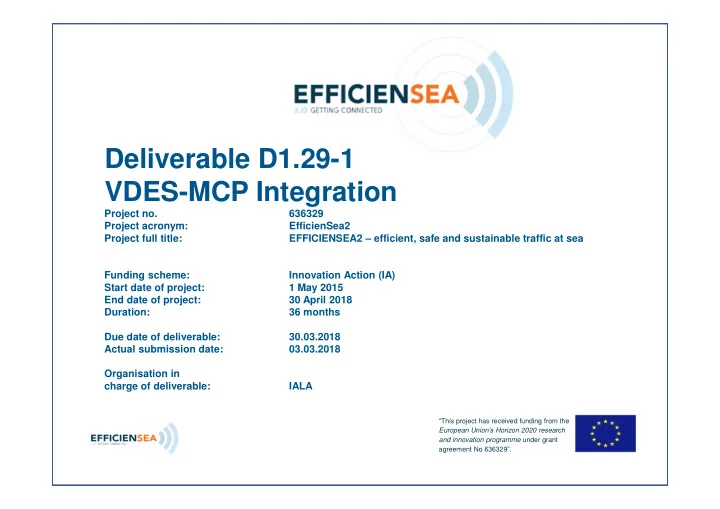

Deliverable D1.29-1 VDES-MCP Integration Project no. 636329 Project acronym: EfficienSea2 Project full title: EFFICIENSEA2 – efficient, safe and sustainable traffic at sea Funding scheme: Innovation Action (IA) Start date of project: 1 May 2015 End date of project: 30 April 2018 Duration: 36 months Due date of deliverable: 30.03.2018 Actual submission date: 03.03.2018 Bringing maritime communications into the digital age! Organisation in charge of deliverable: IALA “This project has received funding from the European Union’s Horizon 2020 research and innovation programme under grant agreement No 636329”.
VDES-MCP Integration Nick Ward, IALA E2 Project Manager Jillian Carson-Jackson, Consultant Jan Safar, GLA R&RNAV THIS PROJECT HAS RECEIVED FUNDING FROM THE EUROPEAN THIS PROJECT HAS RECEIVED FUNDING FROM THE EUROPEAN THIS PROJECT HAS RECEIVED FUNDING FROM THE EUROPEAN UNION’S HORIZON 202O RESEARCH AND INNOVATION UNION’S HORIZON 202O RESEARCH AND INNOVATION UNION’S HORIZON 2020 RESEARCH AND INNOVATION PROGRAMME UNDER GRANT AGREEMENT NO. 636329 PROGRAMME UNDER GRANT AGREEMENT NO. 636329 PROGRAMME UNDER GRANT AGREEMENT NO. 636329
Introduction • Development of VDES and MCP have been objectives of the EfficienSea 2 Project • These developments have been carried out in separate work packages, without much integration • There is potential synergy, but also some problems to overcome • Results of MCP Workshop in Nov 2017 should be noted • VDES-MCP Integration could be subject of a testbed
Background Maritime Connectivity Platform (formerly the Maritime Cloud) Developed as “A communication framework enabling efficient, secure, reliable and seamless electronic information exchange among all authorized maritime stakeholders across available communication systems”, based on the IMO e- navigation strategy. Reaches beyond the IMO strategy, matching the goals of the EU e- maritime initiative and more. Initially encompassing unregulated services, expanding gradually to take in regulated services.
Background VHF Data Exchange System (VDES) Satellite Satellite uplink / monitoring downlink Shore – Ship Ship – Ship Concept developed by IALA and ITU, supported by IMO, in order to: – Protect the Automatic Identification System (AIS) from future overload – Provide data exchange capability to enable e-Navigation applications – Support modernisation of the Global Maritime Distress and Safety System (GMDSS) – Ensure the effective and efficient use of the maritime VHF band
MCP Implementation Workshop E2 Workshop hosted by IALA in November 2017 – relevant outcomes: • MCP and its technical components are in general seen as a good contribution in the maritime domain • MCP is expected to take down barriers of language and communication, it will be a platform for new business opportunities • Regulated systems need to be managed through international standardisation bodies, non-regulated systems can be handled by competent authorities / companies • Selling points of MCP are provision of infrastructure and free services offered….should focus on end-users and the provision of services • Significant body of international regulation applicable to maritime matters, including safety and communication regulation
Synergy/problems • Not for profit • Open source • Safety services • International standardization • Need for Rapid adoption • Need to demonstrate use cases • Need for TCP/IP connection?
VDES-MCP Integration • Option A: VDES to include TCP/IP capability This would see the full functionality of MCP extend to the ship • • Implications for bandwidth available for payload transfer Option B: Interfacing via ‘Non-IP Media Gateways’ • • MCP link to VDES occurs at gateways on land and on-board – no direct connection with MCP to the ship via VDES • MCP uses VDES as a transport mechanism for data with conversion of the payload from the TCP/IP of MCP to the VDES transmission to the ship and vice versa • Messages can be routed between MCP components via the Maritime Messaging Service (MMS) • Other options • Perhaps a hybrid where VDE Terrestrial and VDE Satellite work differently – for example VDE-TER has the TCP/IP capability, whereas VDE-SAT doesn’t?
Proposed VDES-MCP Testbed General • Focus on technical services already developed • Services direct from provider to user in first instance • Use Maritime Identity Registry for VDES message authentication Testbed data • Area Notice • Virtual AtoN • AtoN Information Phased approach • Phase 1: AtoN Provider to own vessels • Phase 2: AtoN Provider to other users • Phase 3: Third party via AtoN Provider to general users
Questions: Is VDES-MCP Integration important? How do we progress it? Is the testbed workable? nick.ward@iala-aism.org jcj@iinet.net.au jan.safar@gla-rrnav.org THIS PROJECT HAS RECEIVED FUNDING FROM THE EUROPEAN THIS PROJECT HAS RECEIVED FUNDING FROM THE EUROPEAN THIS PROJECT HAS RECEIVED FUNDING FROM THE EUROPEAN UNION’S HORIZON 202O RESEARCH AND INNOVATION UNION’S HORIZON 202O RESEARCH AND INNOVATION UNION’S HORIZON 2020 RESEARCH AND INNOVATION PROGRAMME UNDER GRANT AGREEMENT NO. 636329 PROGRAMME UNDER GRANT AGREEMENT NO. 636329 PROGRAMME UNDER GRANT AGREEMENT NO. 636329
Recommend
More recommend